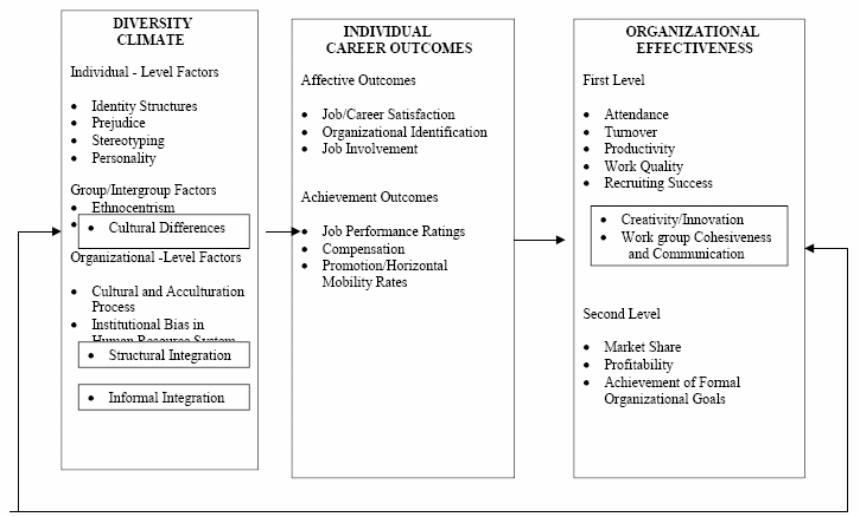Introduction
Human beings can be called complex animals and these results in diversity whether it is in society, home, or the workplace. Diversity can be with regard to culture, economic status, qualification, social status, color, physical differences, and the like. Moreover, growing levels of globalization have resulted in increasing cultural and ethnic diversity. This paper is aimed at studying the factor of diversity climate in organizations. It will also create a model for analyzing diversity and will also attempt to implement the same in a cultural diversity program.
Diversity Climate
Before moving on to the topic, it would be ideal to define the term diversity. Diversity “Includes characteristics or factors such as personality, work style, religion, race, ethnicity, gender, sexual orientation, having a disability, socioeconomic level, educational attainment, and general work experience. Diversity refers to all of the characteristics that make individuals different from each other.” (Adeniyi & Turner, 2005).
It can be seen that diversity is a very large field. This diversity is both advantageous as well as disadvantageous to firms. The advantage is obtained if all the good points of each type of diversity are combined to work for the good of the organizations and the individuals working there. The disadvantage is that this diversity will lead to a lack of understanding among persons. This can lead to suspicion and conflict thereby creating tensions in the workplace and also reducing morale and productivity.
Hence it can be said that a diverse climate will form inside the organization. A diversity climate can be defined as “organizational members’ attitudes and perceptions toward people from cultural groups other than their own.” (Schauber, 2001). Diversity climate can affect the career of the individual worker as well as the organization itself. There are three levels here namely “individual-level factors, group/intergroup factors, and organizational-level factors. (Cox’s 1993 interactional model of cultural diversity: Review of related literature: Chapter 2).
It can also have a bearing on the individual career of employees in two ways. They are effective outcomes and achievement outcomes. The first is how the employee perceives his job, workplace, etc. Achievement outcomes are related to the actual performance of the employee which in turn will affect organizational performance.

Model for analyzing diversity
The following points may be included to form a model for analyzing workplace diversity. This can be in the form of a questionnaire that should be filled up by every employee. This process should be repeated on new recruits and also every five years.
Ask whether the employee works in a culturally diverse work environment. This could include different races, ethnic groups, ladies, diverse job types, income, and social differences. Most large organizations will have all or most of these present.
Next is to ask whether the employee to which classification he belongs. Then he/she should be asked if the treatment given to him/her is different from what is shown to other employees. It would also be necessary to find out to which ethnic, cultural, or racial group he/she belongs to. It would be also necessary to find out if any discrimination is done based on promotions, job assignments, salary, increments, etc exists.
As for the management, they should analyze whether women and minority groups show a larger level of labor turnover than other workers. Models like Hofstede’s cultural dimensions can also be adopted to understand the cultural diversity in the organization. They are the power distance index, individualism, masculinity, uncertainty avoidance, and long-term orientation. Power distance is the difference in power enjoyed by different individuals in a society. Advanced societies tend to have a lower index when compared to developing ones. Individualism is low in developing countries with family size tending to be larger.
In advanced countries, people tend to stay alone or have smaller families. Some cultures have women being more assertive when compared to others where women are dominated by men. Uncertainty avoidance exists in some cultures and they need assurance, familiarity, low risks, etc. some cultures will be more willing for unfamiliarity, lack of order or structure, and be willing to take more risks. Long-term orientation is related to values.
“Values associated with Long Term Orientation are thrift and perseverance; values associated with Short Term Orientation are respected for tradition, fulfilling social obligations, and protecting one’s ‘face.’” (Geert Hofstede ™ cultural dimensions, 2003). Cultural diversity can exist if the employee belongs to any of the categories given below namely “a woman, have any ethnic background that is non-white, are not a heterosexual, are not a Christian, and are not between the ages of 21-50.” (Why does cultural diversity in the workplace matter? cultural diversity in the workplace strengthens in diversity). Implementing the results in a cultural diversity training program involves the following steps.
A review of the organization’s uniqueness in terms of ethical, cultural, and racial differences has to be conducted. All employees should be taught about this uniqueness. They should then be taught about the above three factors and also to appreciate the differences they may have. An analysis of how these differences can affect performance should also be made clear. The final step would be to encourage and enhance intercultural relationships.
Managing all of the above will be a challenging task for any management. it would take time and patience to have a problem-free multi-cultural atmosphere. But once it is achieved, the advantages of having a multi-cultural workforce can be made use of by the organization.
References
Adeniyi, Adedayo., & Turner, Deborah. (2005). Diversity made simple: Understanding important terms. Diversity, Leading Edition: E-Newsletter for Purdue University Supervisors. Web.
Schauber, Ann C. (2001). Journal of extension: Talk around the coffeepot: A key to cultural change toward diversity. Joe.org. Vol.39. Web.
Cox’s 1993 interactional model of cultural diversity: Review of related literature: Chapter 2. P. 19. Web.
Geert hofstede ™ cultural dimensions. (2003). ITIM: International. Web.
Why does cultural diversity in the workplace matter? cultural diversity in the workplace strength in diversity. Leadership-Tools.com. Web.